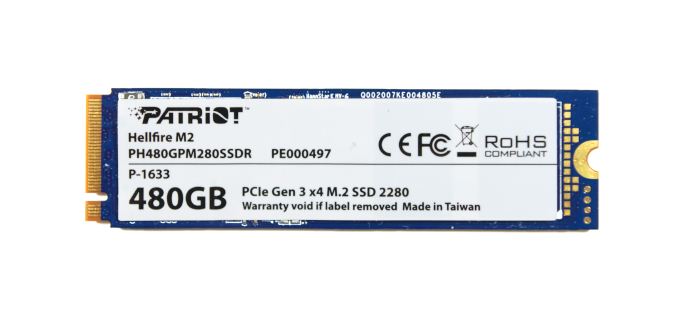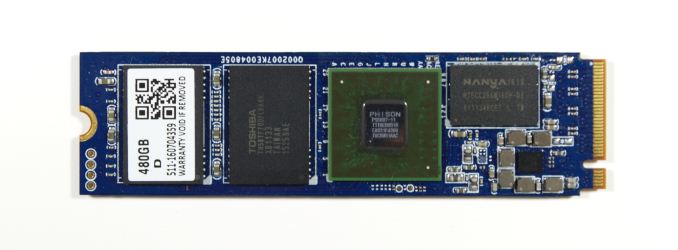The Patriot Hellfire M.2 480GB Review: Phison NVMe Tested
by Billy Tallis on February 10, 2017 8:30 AM EST
The Patriot Hellfire M.2 PCIe SSD is Patriot's first NVMe SSD, and one of several similar products based on Phison's E7 NVMe controller. As usual for Phison, the same drive is manufactured for many of their partners, who typically customize only the branding. Phison designs the controller, firmware, and PCB, but leaves the marketing up to their partners.
Phison's PS5007-E7 controller is their first NVMe SSD controller, supporting a PCIe 3.0 x4 host interface and 8 channels for NAND access. The details we have on the E7 are a bit slim - some collection of ARM cores under the hood is a safe bet, but that's it - however we do know that the E7 controller is manufactured on TSMC's 28nm process and uses FCBGA packaging. Interestingly, it doesn't use the kind of large heatspreader we've seen on competing controllers like Silicon Motion's SM2260. Phison had the E7 platform hardware ready over a year ago, but retail releases were held back by the poor performance of early firmware. Patriot first began shipping the Hellfire last fall, but even after that much delay, they ended up issuing a firmware update shortly after launch.
Phison's controllers are almost always paired with Toshiba's NAND flash, and the Patriot Hellfire uses Toshiba's 15nm MLC. Our review sample is the 480 GB version, the most common capacity for E7 SSD. Patriot also sells a 240 GB version, and some of their competitors offer the 120GB version as well.
| Patriot Hellfire Specifications Comparison | |||
| 240 GB | 480 GB | ||
| Form Factor | M.2 2280 | ||
| Controller | Phison PS5007-E7 | ||
| Interface | NVMe PCIe 3.0 x4 | ||
| DRAM | 256MB DDR3L | 512MB DDR3L | |
| NAND | Toshiba 15nm MLC | ||
| Sequential Read (CDM) | 2740 MB/s | 2550 MB/s | |
| Sequential Write | 1090 MB/s | 1260 MB/s | |
| 4KB Random Read (QD32) | 170k IOPS | 170k IOPS | |
| 4KB Random Write (QD32) | 185k IOPS | 210k IOPS | |
| Warranty | 3 years | ||
| MSRP | $130 (54¢/GB) | $230 (48¢/GB) | |
The Phison E7 controller was originally intended to be a high-end NVMe controller for client or enterprise use. By the time it was ready for the market, Samsung had raised the bar far too high for the E7 to still be considered high-end. But Phison E7-based SSDs like the Patriot Hellfire have been able to offer very attractive pricing and are usually the cheapest MLC-based NVMe SSDs available. Without the pitfalls of TLC-based SSDs like the Intel SSD 600p and the Samsung 960 EVO, the Patriot Hellfire and its relatives have been attractive entry-level PCIe SSD options.
Aside from other Phison E7 SSDs, the closest competition for the Patriot Hellfire is the Plextor M8Pe, based on the same Toshiba 15nm MLC NAND but using the Marvell 88SS1093 controller with Plextor's own firmware. The Patriot Hellfire also has to justify its higher price relative to the Intel SSD 600p, the most affordable NVMe SSD, and against high-performing SATA SSDs like Samsung's 850 EVO and 850 PRO.
| AnandTech 2015 SSD Test System | |
| CPU | Intel Core i7-4770K running at 3.5GHz (Turbo & EIST enabled, C-states disabled) |
| Motherboard | ASUS Z97 Pro (BIOS 2701) |
| Chipset | Intel Z97 |
| Memory | Corsair Vengeance DDR3-1866 2x8GB (9-10-9-27 2T) |
| Graphics | Intel HD Graphics 4600 |
| Desktop Resolution | 1920 x 1200 |
| OS | Windows 8.1 x64 |
- Thanks to Intel for the Core i7-4770K CPU
- Thanks to ASUS for the Z97 Deluxe motherboard
- Thanks to Corsair for the Vengeance 16GB DDR3-1866 DRAM kit, RM750 power supply, Carbide 200R case, and Hydro H60 CPU cooler











43 Comments
View All Comments
lilmoe - Friday, February 10, 2017 - link
It's sad that all these non-Samsung MLC NVMe SSDs can't even compete with the TLC 960 Evo... But then again, which has more endurance? VNAND TLC or 15nm MLC?bug77 - Friday, February 10, 2017 - link
V-NAND TLC has about the same number of p/e cycles as planar MLC.Bullwinkle J Moose - Friday, February 10, 2017 - link
"Which has more endurance" is a false choice!You need to specify Brand, Process, Controller and Firmware Version when comparing endurance
Mixing MLC and TLC also does not help in the least
I pay less over time for a better process like 40nm Samsung MLC than I do for a cheaper process like 15nm Toshiba MLC, even though the initial cost of the Samsung is higher
Likewise, you should only compare TLC with TLC
The only Non-Endurance issue I've ever had with 3D V-Nand is that I had to update Acronis True Image from the 2012 version to 2015/16 or 17 so the backups would restore correctly
guidryp - Friday, February 17, 2017 - link
That makes no sense.MLC has more endurance than TLC.
Adding more layers to TLC doesn't improve endurance.
lilmoe - Monday, February 20, 2017 - link
That's 40nm TLC vs 15nm MLC... I'd vouch for Samsung's process, and vertically integrated product.bogdan.anghel1986 - Friday, February 17, 2017 - link
can't even compete? this SSD is priced about the same with a 850 EVO SATA3, and a lot faster. try not to compare it with other SSD's that cost double. in reviews they put it up against the best so you can have an ideea where it sits.do you compare a Lamborghini with a VW Polo ?
lilmoe - Monday, February 20, 2017 - link
You call 20$ a difference for NVMe drives? Really? Lambos cost 20 times more than Polos, the heck is wrong with you?Arbie - Friday, February 10, 2017 - link
"Hellfire" - for a disk drive? If I buy this, I'd be promoting stupid naming. There's a point in such things where the prospective customer is simply being insulted. Hard to define, but "I know it when I see it".Murloc - Friday, February 10, 2017 - link
Everybody has a naming scheme. What's wrong with copying names already used by weapons, for a company named patriot?Hellfire sounds stupid but other missile names aren't much better, or they're boring.
BrokenCrayons - Friday, February 10, 2017 - link
Well, have a nap and then FIRE ZE MISSILES!!!